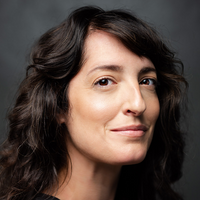On relearning what you knew as a child
Prelude
Sarah Martinus is an artist, healer, and independent researcher, working technically with subtle body energies and their complex interconnected relationship within environment. Across abstract image, ritual, and sound, she addresses the inner-experience as product, holding concurrent metaphysical spaces and paradox in acknowledgement of the non-dual. Her focus into the holistic psychic rhythms of the un-manifested, explores identity, embodiment, psyche, spirit, emotion and co-emergent multitudes within the individual and collective. You can find out more about her projects, research, workshops, and one-one-sessions at her website.
Conversation
On relearning what you knew as a child
Artist, healer and writer Sarah Martinus discusses constellating oneself, safe spaces for resistance, the power of rituals, and why remembering is important for creating.
As told to Grashina Gabelmann, 2217 words.
Tags: Magic, Art, Writing, Music, Process, Inspiration, Mental health.
Can you describe your art practice to me?
I work with metaphysical substances that I feel through my body or that I pick up on through dreams—shamanic journeys, interactions with people or interactions with animals and plants and living things. And there’s a few different portals that this content goes into with my work. One is dance music, because I see the dance floor as an amazing space of collective transformation, transmutation and protest. And as ambient music sound healing practices where I have my drums and rattles and a gong. And then I also paint abstractly, draw, and write about my research into energy dynamics.
A few years ago, I realized that I worked in a way that one could classify as “shamanic” or more specifically Core Shamanic because the central point in my artistic practice was always energy power and how power moves and it was always connected with my body. I was always responding to environment on a very deep level and across multiple mediums. So, I see everything I create as all interconnected flowing between the material world and the immaterial world. All the art I create is based on the process. The process has been and is so healing for me because it helps me digest on a psychic level, a ceremony. Painting, for me, is psychic digestion. It takes a lot of joy out of it for me if I already know what I need to paint.
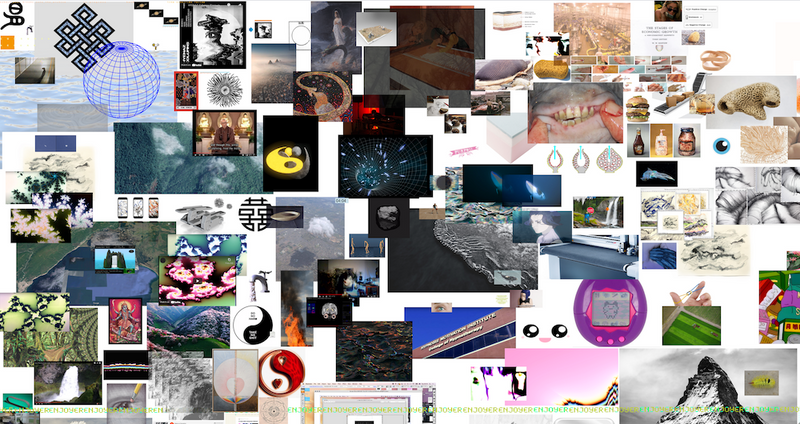
Consumer Refund Web Portal, Sarah Martinus, 2020
How do you connect shamanism to your art practice and what does shamanism mean in that context?
My pathway into studying Core Shamanism with the Foundation of Shamanic Studies in Europe began in 2015 when I was having extremely intense dreams and I was going through what I would classify as a psycho-spiritual crisis. Parts of me were so skeptical that it did take six or so years to get really into it. It took a lot of research, creating, and seeing synchronicities that came up between all different things to get really into it. I also got into tarot, oracles, and astrology and a lot of other non-linear systems measuring our relationship with the universe and environment. But shamanism, for me, really brought back a huge connection with inner worlds and intuition. I could see immediately how expansive and supportive this could be for every creature, every human. It was an amazing technique to have found to create the basis of an art practice.
How do shamanic techniques flow through your art practice?
It’s super individual and when we’re talking about westernized practices or future-focused practices of ancient techniques, I think it’s very important to specify context. When I talk about shamanism within future-focused artistic practice, I am not directly likening this with the indigenous peoples’ practices. I have a huge amount of respect to honor our true wisdom keepers, and am cautious about my words to make sure that I’m not simply appropriating something which hasn’t authentically grown from within my own self. And so with that, I just want to say that the way I understand my shamanic practices is born of an urban life. And a life of being “Sarah,” even if I have been tapping into something nameless, much deeper and older. And so if you’re talking about ancient shamanism, that would be something else outside of my practice. I do learn and read as much as I can about different tribes and different origins of practices, but I think for contemporary artists, especially in westernized environments, it’s important for us to develop our personal practices that are authentic to ourselves, and then try to relate to our society through this passageway we have taken.
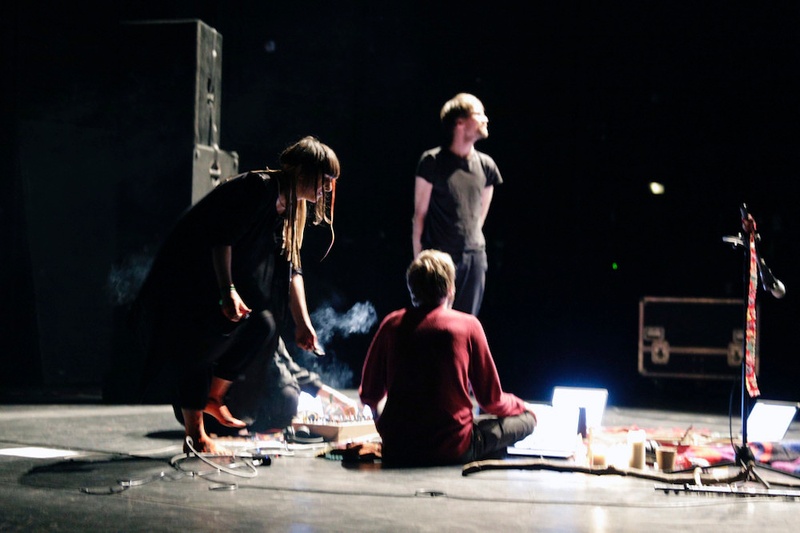
Swarm Animinism by Spirit Casual; Photo Credit: CTM Festival
So when you say your shamanic practice and your artistic practice are connected, can one imagine that you use shamanism to access parts of yourself that you can then express artistically?
I would say it’s a way of life. And I’m really cautious about idea of “using something.” Shamanism made me understand that there are spirits (ie: information) all around: the trees are besouled, my house is besouled, my computer is besouled. With the understanding that everything is besouled, you start to allow yourself to be in mutual relationship with your environment. And then the idea that you’re “using a technique” falls away and you realize that the techniques are using you. Like, I walk into the garden and a leaf falls on my head and then I have an idea and well, how central is the concept of I in that? This is very interesting for me and it’s gotten me into enjoying co-emergence and understanding that when I have dreams, I don’t necessarily have the dream, the dream has me.
I like your thought of the technique using you.
Every child comes into this world as very creative. The natural way that a creative being enacts a relationship with their environment is always through receiving and giving messages and testing things. We’re in complex networks here so I think that for me, it was really coming back to things I already knew from when I was very young.
Sometimes the process is more about unlearning rather than learning.
Definitely. The unlearning process is important because it’s about moving power or it would be from a Core Shamanic perspective. I think that if we’re looking to evolve the systems we live in, we need to learn about them to a certain extent. Then when you’ve learned enough, it’s time to unlearn.
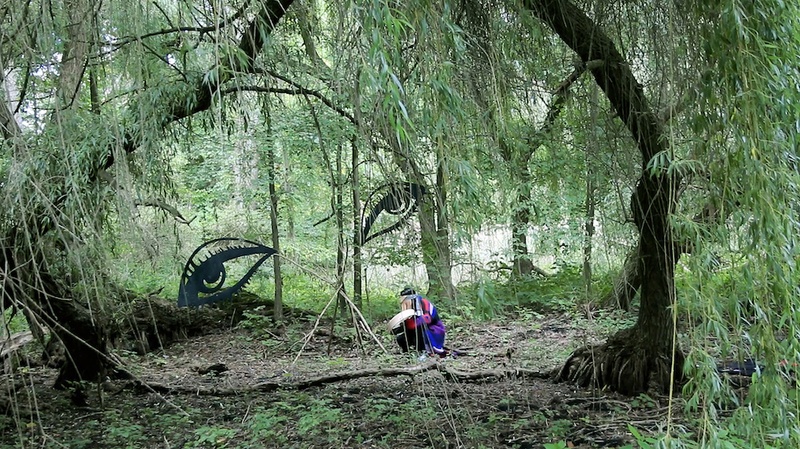
Sternhagen Gut Residency, video still, Sarah Martinus.
A Carl Jung quote popped into my head: “The best political, social, and spiritual work we can do is to withdraw the projection of our shadow onto others.”
Beautiful quote. There’s a lot of people who talk about that loss of innocence, the falling of the projection and withdrawal of the shadow—which hurts—as being necessary to break open a shell around the soul so that the soul’s potential can burst through like a balloon. James Hillman talks about that in the Acorn Theory. For the cycle of creativity and destruction to exist, there needs to be resistance, conflict. That inner conflict provides opportunity for transcendence, the real “new.”
It reminds me of something you wrote on your website: “Life is working for us. If you’re always challenged, you are always awakening.”
Becoming okay with resistance is a part of real growth expansion, if we are going to actively propel ourselves towards abundance. I believe that many of us need to unlearn the belief that “life does not support us” or that “there’s not enough to go around,” that we are in scarcity and in competition with one another. If feeling uncomfortable is too much for us to bear psychically and we keep jumping away from resistance, we get smaller and smaller and smaller. And alternatively, it’s really important for people to have safe spaces where they can talk about the resistance that they’re going through and be held in dealing with this resistance because that’s the only way we can rearrange the psychic constellation of our scarcity mindsets enough to allow new life to come in from where the resistance is taking us.
That’s hard to do on one’s own.
Yes, it’s a process that needs companionship with very grounded witnessing and that’s really what inspired me and propelled me to make sure that I offer this as part of my practice, one-on-one sessions with people where I can assist in holding and growing that psychic container.
I find your term “psychic container” really beautiful. I got this image of a nebulous, floating container within myself that gets filled up when I do things like rituals.
I think that action and ritual as experience can ground your spirit back in your body, into your flesh, and it is really important for the psychic container to actually be connected to embodiment because the body is such an archive of soul power. With the birth of the digital age so much of our lives dissolve into immateriality through the internet and we dissociate ourselves from the body.
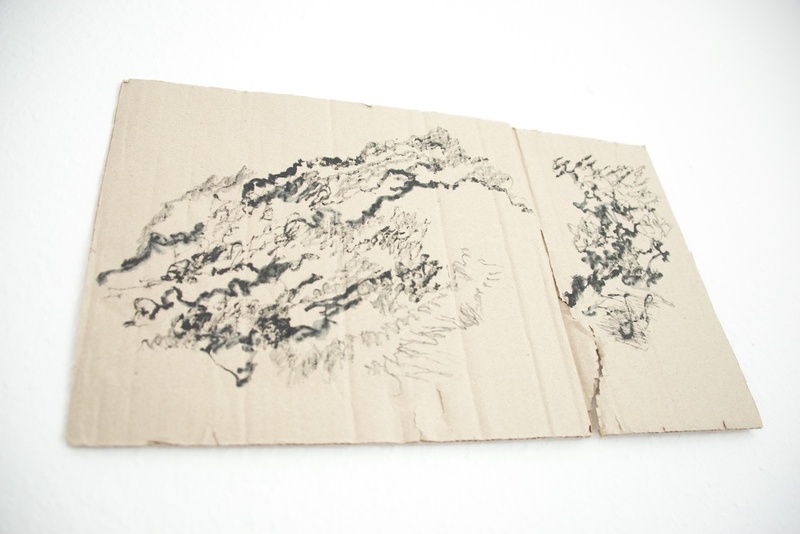
Mindlessness Technique Wolf, Sarah Martinus
The body as an archive of soul power is a wonderful concept.
There’s power passing through us in all that we do—like writing an email or cooking a meal. Intention gets catalyzed into sensation and then sensation flows into whatever you’re doing. In that way, there’s a spirit inside of cooking a meal or writing an e-mail.
I had to think of values while you were speaking. When I do something that is “mundane” like writing an email, can I do it in a way that transports the values that I hold? Could that be a sort of ritual helping you align with your inner values?
Yes. It makes me remember a quote from Donald Kalsched’s book Trauma and the Soul: “To teach a thing of beauty.” So much happens to us in this world that makes us forget our spiritual selves, makes us forget about our own beauty; DIS-memberment. It is important to RE-member and to allow that to pass from our bodies into what we create. That doesn’t mean that we only have to create things that are beautiful in a certain perspective of what beauty is but that one can partake in rituals as a way of RE-memberment or teaching yourself that you are beauty. “To teach a thing its beauty” is part of the unlearning process.
I want to talk to you about rituals and routine as someone with an artistic practice.
I would say that the most important aspect of a ritual for me is the acknowledgement of the numinous, the acknowledgement that there is something far greater around me that I will never understand, that I bow down to as Mystery. I see ritual like an invitation for the Great Mystery to mingle with our current situation. And the more that one gives offerings and makes sure to remember that the numinous exists, the more you are in good faith, or ‘right relationship’. As much as ritual is about honoring something outside of ourselves, it’s also about honoring something inside of ourselves. And if you take this back to a place of prayer where you’re respecting that you’re not the center of the universe and that you’re not totally in control of everything, then you can really get back to mediating the energetic flow and the energetic rhythms of how you are in existence. Rooting is happening throughout our whole lives all the time. We’re in rhythms and the seasons come and go and the creative cycle has rhythms. And the moon has a rhythm and everything around us has a rhythm. I don’t like the idea of living a life that does not acknowledge these rhythms. For me, ritual helps to keep that alive in my consciousness even if I’m having an especially pragmatic day. Ritual can really ground and connect me with the aspect of oneness.
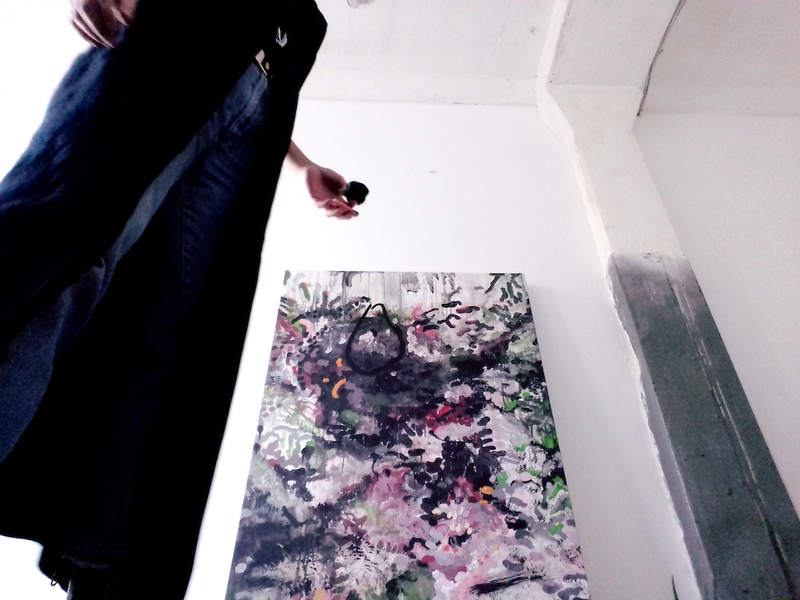
in the studio with Forest, Sarah Martinus
What’s an example of a ritual you like to do?
If I come to a new space to make artwork, I will always check which direction North, East, South, and West is. Getting constellated is important. If we constellate ourselves and we learn how to ground ourselves with ritual, within these moving spirits or energies in the body, then people can learn to self-heal.
Constellating, I feel, is such an important art technique and healing technique. Like you can see constellating across so many different psychotherapy practices and psychoanalysis practices and dreamwork practices. I think Joseph Campbell has a beautiful quote saying the mystic plays in the same waters in which the psychotic drown. And by that I mean to say that these waters that we’re all swimming through, they can be navigated but they need to be navigated with abstract consciousness through symbols and through rituals and through actions. Knowing how to navigate and constellate these liminal differences as we heal deep splits within ourselves and awaken on the pathway towards witness consciousness is vital.
Sarah Martinus Recommends:
The community and research of the Foundation of Shamanic Studies, Europe.
On the hidden “shamanic” nature of Greek Mythology, for western minds who are taking the initiatory process of unlearning - In The Dark Places of Wisdom -Peter Kingsley
On understanding trauma, diabolical spirit and most importantly, the appearance of the spirit crone, [grandmother cosmos] - documented from a Jungian psychoanalytic perspective - “Trauma and the Soul” - Donald Kalsched
Open access teachings of Marcella Lobos and Alberto Villoldo, which are shared through a descriptive blog.
Rob Brezsny’s Free Will Astrology Newsletter, “a celebratory array of tender rants, lyrical excitements, poetic philosophy, and joyous adventures in consciousness” from Rob.
- Name
- Sarah Martinus
- Vocation
- artist, healer, writer
Some Things
Pagination
